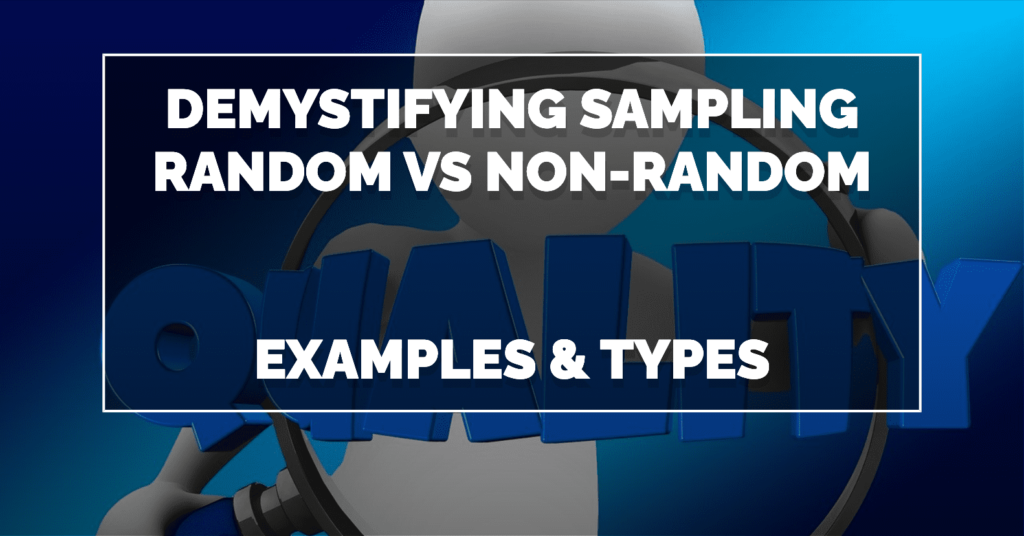PROJECT MART - College Project Service
For help with an academic project, text right now.
Sampling is a crucial aspect of research methodologies, allowing researchers to draw conclusions about populations based on a subset of data. There are two main categories of sampling methods: random and non-random. In this blog, we will delve into the differences between these two approaches, provide examples to illustrate their application, and explore the various types within each category.
Random and Non-Random Sampling: Explained
Random Sampling: Random sampling involves selecting individuals from a population in such a way that every member has an equal chance of being chosen. This method aims to eliminate bias and ensure that the sample is representative of the entire population. Random sampling relies on probability theory to ensure fairness in selection.
Non-Random Sampling: Non-random sampling, on the other hand, involves selecting individuals based on criteria that are not purely random. This approach may introduce bias into the sample, as certain individuals are more likely to be included than others. Non-random sampling methods are often chosen for their practicality, convenience, or specific research objectives.
Random and Non-Random Sampling: Examples
Random Sampling Example: Suppose a researcher wants to study the average income of households in a city. They could use random sampling by assigning each household a number and then using a random number generator to select a subset of households for inclusion in the study. This ensures that households of varying income levels have an equal chance of being selected, providing a representative sample for analysis.
Non-Random Sampling Example: In contrast, consider a scenario where a researcher wants to study the opinions of customers about a new product. They might choose convenience sampling, approaching individuals who happen to be in a particular store at a given time. While this method is quick and easy, it may not accurately represent the opinions of all customers, as it excludes those who are not present in the store during the study period.
Random and Non-Random Sampling: Types
Types of Random Sampling:
- Simple Random Sampling: Every member of the population has an equal chance of being selected, with each sample drawn independently of the others.
- Systematic Sampling: Individuals are selected at regular intervals from a population list after a random start.
- Stratified Sampling: The population is divided into homogeneous subgroups, or strata, and random samples are then taken from each subgroup.
Types of Non-Random Sampling:
- Convenience Sampling: Researchers select individuals who are readily available or easily accessible.
- Purposive Sampling: Participants are chosen based on specific characteristics or criteria relevant to the research question.
- Snowball Sampling: Initial participants are selected, and then additional participants are recruited based on referrals from the initial participants.
Random Sampling Project Ideas:
Health Survey in a City: Randomly select households in a city and conduct health surveys to assess prevalent health issues, healthcare access, and lifestyle habits. Analyze the data to identify correlations between socio-economic factors and health outcomes.
Market Research for a New Product: Use random sampling to select participants from a target demographic and gather feedback on a new product or service. Analyze responses to determine market demand, pricing preferences, and potential improvements.
Opinion Polling for Elections: Conduct random sampling to select voters and gather their opinions on political candidates and issues leading up to an election. The data can be used to predict election outcomes and understand voter sentiments.
Educational Assessment in Schools: Randomly select students from different schools and administer standardized tests to assess academic performance. Analyze the results to identify strengths and weaknesses in the educational system and inform curriculum development.
Environmental Monitoring: Randomly select sampling sites across a region and collect environmental data, such as air quality measurements or water samples. Analyze the data to assess environmental health and identify areas for improvement or conservation efforts.
Non-Random Sampling Project Ideas:
Convenience Store Shopper Behavior: Conduct a study on shopper behavior at convenience stores by observing and interviewing customers as they make purchases. Analyze the data to understand buying patterns, product preferences, and factors influencing purchase decisions.
Interviews with Key Informants in a Community: Identify key informants in a community, such as local leaders or activists, and conduct interviews to gather insights on community issues and priorities. Use the information to guide community development initiatives.
Case Study of Successful Businesses: Select a sample of successful businesses in a particular industry and conduct in-depth case studies to explore factors contributing to their success. Identify common strategies and best practices that can be applied to other businesses.
Focus Group on Social Media Usage: Recruit participants for a focus group discussion on social media usage patterns and attitudes. Facilitate discussions on topics such as privacy concerns, online behaviors, and perceptions of social media platforms.
Qualitative Analysis of Online Reviews: Collect online reviews of a product or service from websites such as Amazon or Yelp and perform qualitative analysis to identify common themes and sentiments among customers. Use the findings to improve product/service quality and customer satisfaction.
Conclusion
In conclusion, random and non-random sampling methods each have their own advantages and limitations. While random sampling aims to provide unbiased and representative samples, non-random sampling methods are often chosen for their practicality and efficiency. Researchers must carefully consider the goals of their study, the characteristics of the population, and the potential sources of bias when selecting a sampling method. By understanding the differences between these approaches and choosing the most appropriate method for their research, researchers can ensure the reliability and validity of their findings.







